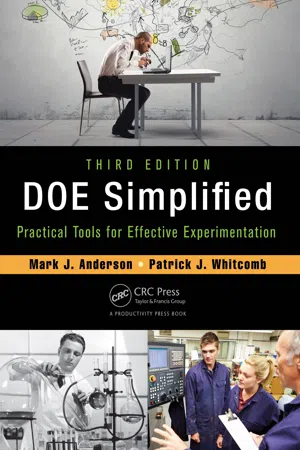
DOE Simplified
Practical Tools for Effective Experimentation, Third Edition
- 268 pages
- English
- ePUB (mobile friendly)
- Available on iOS & Android
About This Book
Offering a planned approach for determining cause and effect, DOE Simplified: Practical Tools for Effective Experimentation, Third Edition integrates the authors decades of combined experience in providing training, consulting, and computational tools to industrial experimenters. Supplying readers with the statistical means to analyze how numerous variables interact, it is ideal for those seeking breakthroughs in product quality and process efficiency via systematic experimentation.Following in the footsteps of its bestselling predecessors, this edition incorporates a lively approach to learning the fundamentals of the design of experiments (DOE). It lightens up the inherently dry complexities with interesting sidebars and amusing anecdotes.The book explains simple methods for collecting and displaying data and presents comparative experiments for testing hypotheses. Discussing how to block the sources of variation from your analysis, it looks at two-level factorial designs and covers analysis of variance. It also details a four-step planning process for designing and executing experiments that takes statistical power into consideration.This edition includes a major revision of the software that accompanies the book (via download) and sets the stage for introducing experiment designs where the randomization of one or more hard-to-change factors can be restricted. Along these lines, it includes a new chapter on split plots and adds coverage of a number of recent developments in the design and analysis of experiments.Readers have access to case studies, problems, practice experiments, a glossary of terms, and a glossary of statistical symbols, as well as a series of dynamic online lectures that cover the first several chapters of the book.
Frequently asked questions
Information
Chapter 1
Basic Statistics for DOE
One thing seems certain—that nothing certain exists.
Statistics means never having to say you’re certain.
Go Directly Tojail
- Type I: Saying something happened when it really didn’t (a false alarm). This is often referred to as the alpha (α) risk. For example, a fire alarm in your kitchen goes off whenever you make toast.
- Type II: Not discovering that something really happened (failure to alarm). This is often referred to as the beta (β) risk. For example, after many false alarms from the kitchen fire detector, you remove the battery. Then a piece of bread gets stuck in the toaster and starts a fire.
Decision-Making Outcomes | What You Say Based on Experiment: | ||
Yes | No | ||
The Truth: | Yes | Correct | Type 2 Error |
No | Type 1 Error | Correct | |
The “X” Factors
- Computer simulation

- Analytical instrument

- Manufacturing process

- Component in an assembled product

- Any kind of manufactured “thing” or processed “stuff”


SPC | DOE | |
Who | Operator | Engineer |
How | Hands-off (monitor) | Hands-on (change) |
Result | Control | Breakthrough |
Cause for Variability | Special (upset) | Common (systemic) |
Talk To Your Process (And It Will Talk Back To You)
“When I took math class, I had no problem with the questions, it was the answers I couldn’t give.”
Does Normal Distribution Ring Your Bell?
Table of contents
- Cover
- Halftitle Page
- Title Page
- Copyright Page
- Table of Contents
- Preface
- Introduction
- 1 Basic Statistics for DOE
- 2 Simple Comparative Experiments
- 3 Two-Level Factorial Design
- 4 Dealing with Nonnormality via Response Transformations
- 5 Fractional Factorials
- 6 Getting the Most from Minimal-Run Designs
- 7 General Multilevel Categoric Factorials
- 8 Response Surface Methods for Optimization
- 9 Mixture Design
- 10 Back to the Basics: The Keys to Good DOE
- 11 Split-Plot Designs to Accommodate Hard-to-Change Factors
- 12 Practice Experiments
- Appendix 1
- Appendix 2
- Glossary
- Recommended Readings
- Index
- About the Authors
- About the Software